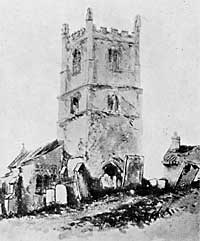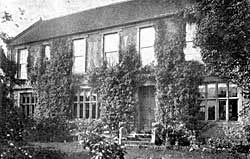 |
| Old drawing of Hucknall parish church. |
The 17th Century.
A tablet in the church records that Sir Richard Byron, famous for his defence of Newark in the Civil War, and who in 1652 became second Lord Byron, and "the rest of his family, being seven brothers," fought and suffered for their loyalty to King Charles. Skirmishes took place in and around the village and the bones of slain men are reputed to have lain unburied to bleach in the sun. The Byron properties would be pillaged and were ultimately seized by Parliament and it is reputed that the church was raided and its plate taken away; but shortly before the Restoration the properties were recovered, their profits having been received, "for the Service of the (Commonwealth) State."
The subsidy Rolls of 1647 reveal that Hucknall was then smaller than Mansfield Woodhouse Teversal, Kirkby, Sutton, Annesley or Selston. Mr. Beardsmore's computation that the population towards the end of the 16th century was about 450 must be regarded as excessive, for an official return of 1603 shows that was then no more than 317 of whom 106 were children under 16.
In 1650 the puritan vicar was reported to be "a preaching minister, but, a drunkard and common swearer,", and in 1654 it was ordered that Hucknall Torkard, Linby, Newstead and Papplewick be consolidated into one ecclesiastical parish, but Lord Byron was able to put up such an opposition that the order' became inoperative.
The Restoration witnessed in 1661 the marriage of the Hon. William Byron, son and heir of the 2nd Lord Byron, and the daughter of Viscount Chaworth of Annesley—a union the poet-lord sought in vain to emulate 150 years later! In 1662 the parson who had succeeded the hard-drinking vicar was ejected and replaced by a clergyman of the Established Church who reported in 1676 that he had 167 adult parishioners, none of whom were papists, and only four were regularly absent, from church. He probably turned a blind eye upon the absentees for at the very same time a bitter persecution of Quakers was in full blast and more than one Hucknall man "was sold up to raise the fines imposed upon them.
Thoroton, writing at that time, stated that "there are now reckoned to be four or five manors of which the Hon. William Byron (of Bulwell Wood Hall) hath two; the Earl of Essex, lord of Beauvale hath one; Lancelot Rolleston, esq. hath one; and Lancelot Curtis also hath one hero.'' If it had not been beneath the Doctor's dignity to notice it he might have added to his account that the village then possessed the unusually large number of four inns, and that popish recusants were being prosecuted for absence from church.
18th Century Changes.
 |
| Bulwell Wood Hall, c.1900. |
Somewhere about the end of the 17th century Bulwell Wood Hall ceased to be a residence of the Byrons and became occupied by the Trumans; who tenanted it until the present century. About 1758 six of its rooms were destroyed by fire, and there is a picturesque story that being convicted of manslaughter for his fatal duel with Mr. William Chaworth, and having paid his fees as a peer to escape further punishment, the 5th Lord Byron rode in one rnad flight from Westminster towards Newstead and that his over-wearied horse failing to clear the last gate of the Hall estate broke its back and died.
When George III mounted, the Throne in 1760 the village still retained much of its old appearance. The occupants of its 200 single-storey cottages, mostly thatched, were chiefly employed in hosiery work or agriculture. There were open fields in the centre of the parish with extensive woods and much uncultivated waste, but in 1769 an Enclosure Act was obtained, and by 1771 some 1,200a. had been enclosed, 120a. of land being sold at about £18 per acre to defray expenses. It is worth noting that Lord Byron, as lord of the manor, was awarded less than 27a. "for his right and interest as lord of the soil, and to the timber and minerals upon or under the common and waste lands" where the pits are now so busy!
Mr. Beardsmore tells that until about 1800 Bulwell Wood Hall stood within its own park and that at the opening of the 18th century "the village lanes were rutty, winding, and uneven, and most of the cottages mean and squalid, for the people were poor, taxes heavy and employment scarce and ill-paid." The picture is "ower true" and low wages and poverty were reflected in local conditions for long to come. In 1811 there were Luddite riots and the prevalent squalor was commented on by successive visitors during the next half century.
Tho village consisted, mainly of one street down which ran an open sewer and there were no sidepaths. Until, and even after, the opening of the pits in 1861, there was no proper sanitary system and cast-out ordure offended sight and smell and invited disease. Dwellings were still for the most part one-storied, built of local stone and whitewashed outside, with roofs thatched with straw or ling, and Matthews, who in 1866 was writing his account of Sherwood Forest, found the "little church sadly out of repair, divine service being no longer held there," while "it was just then a, matter of dispute as to whether it should be repaired or come down." It was nor until the sinking of the, coalpits and the coming of the Shetland shawl works and the cigar factory about that time that prosperity dawned and Hucknall passed from a benighted village to a town with an increasing population for which every modern amenity was provided.
